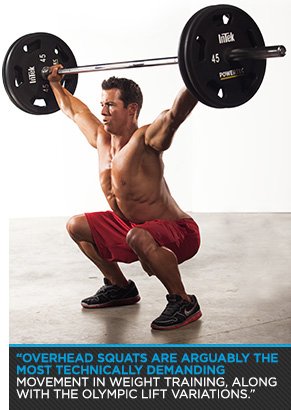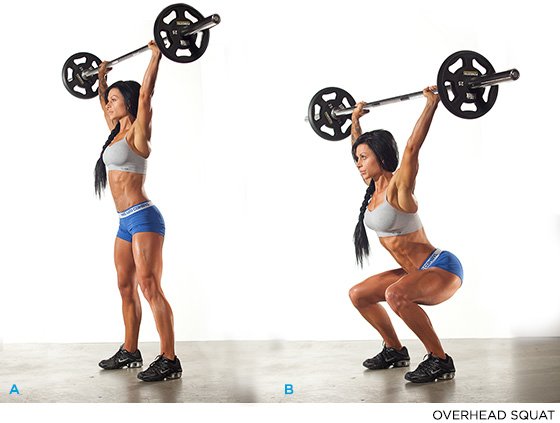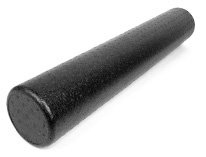As a trainer, I come across too many people who want to build their body with shortcuts and cheats. Cutting technique corners is one thing, but ignoring important exercises is another. Gym rats usually shy away from movements that exploit their weak links, sticking to staples like the biceps curl. If you want to strengthen your weaknesses, challenge your entire body, and unlock new growth, the overhead squat is a killer place to start.
Overhead squats are arguably the most technically demanding movement in weight training, along with the Olympic lift variations. They have tremendous positive effects on mobility, squat depth, back strength, and stability, especially where it translates to other lifts. You have to practice the overhead squat to master the movement, but it's damn hard.
That's where I come in. This step-by-step guide to the overhead squat will help you master the movement and correct common problems. Keep in mind that the overhead squat is not a movement to approach lightly. If you have a history of shoulder issues, impingement, or terribly poor range of motion due to some limitation, don't play around with this exercise.
Overhead Squat Cues
Before you simply press a barbell overhead and squat as deep as you can, keep these three cues in mind:

1 / Grip
Different grips make muscles work in different ways. A narrow-hand grip allows for much more shoulder mobility and flexibility, which is crucial for powerful overhead squats.
For general purposes, I recommend a grip that creates a 90-degree angle at the elbow when the arm is bent and the bar an inch above your head. Use a closed-grip with your thumb around the bar and grip it tightly. Think about squeezing the life out of the bar. Tightness is the key.
When the bar is overhead, your elbows should be completely locked out; no "soft" joints. Focus on applying outward tension to the bar. This allows the muscles in the upper back and rear shoulders to contract and create much more shoulder stability to avoid an irregular bar path.
2 / Bar Travel
In every vertical pushing or pulling exercise (squat, deadlift, high pulls, standing press, cleans, snatch), the bar must travel in a straight line when viewed from the side. As you progress through the overhead squat, the bar will appear to travel backward, to a slight degree, relative to the head and chest position.
The goal is to keep the torso as vertical as possible to create the least shoulder compromise. Maintaining the bar's path over the middle of your feet will be sensitive to how mobile your shoulders are and how well you can extend your spine as you descend.
3 / Squat
The same cues apply to the overhead squat as with any squat variation. However, it's a good idea to focus on a knee break over a hip break because of the position of the load. This means that you should start your descent at the knees, not the hips. Control your descent and maintain tightness in the upper back and posterior chain through the movement.

More than likely, your depth will be compromised because the lift asks for more hip mobility. Your back arch will disappear quicker into the descent because the hands are positioned overhead, which makes you lose tightness and compromise depth. To increase your range of motion from the start, lift your heels 1-2 inches by standing on thin plates.
Overhead Squat Issues
Most guys who focus on getting bigger aren't worried about flexibility or mobility. The overhead squat asks for both to be on their A-game. Poor mobility and an inadequate range of motion in the upper body usually stymie good performance in this lift, so let's correct two of the most common problems.
1 / Poor Shoulder Mobility
The shoulder is a ball and socket joint. The head of the humerus fits into the glenoid fossa similar to the way a golf ball sits in a tee. The range of motion the shoulder is supposed to go through, known as circumduction, is absolutely huge. Training the muscles on both sides of the shoulder (front and back) can lead to proper muscle balance, but unfortunately, most guys don't train for balance.

Most guys train the mirror muscles—chest, delts, and arms—much more than they should. As a result, the upper back muscles get no love. The subsequent tightness takes away from the shoulder's ability to rotate properly. That voids a lifter from getting the bar into the right starting position, let alone staying there while squatting.
Quick fix: Work first on muscle flexibility in the chest and shoulders by way of static stretching, and then focus on tissue quality and mobility work. Foam rolling and trigger-point rolling the chest and shoulders, coupled with shoulder "dislocates," shown in the video below, are key to increasing shoulder range of motion. Don't forget to attack your upper back and pull your upper body into balance!
Lee Boyce on OH Squats
Watch The Video - 02:22
2 / Poor Thoracic Extension
The thoracic vertebrae, or T-spine, compose the middle segment of your vertebral column. The T-spine is most responsible for mobility and trunk movement. When the T-spine can't extend, it affects several processes like scapular retraction, back activation, and shoulder rotational mobility. To correct poor thoracic extension, you need to "release" the pecs, intercostals, and even the lats, while activating the traps.
Quick fix: Focus on thoracic spine extensions using a foam roller. The roller placed under the shoulder blades allows you to "open up" the tissue on the front of the body, including the pecs and abdominals, to encourage better flexibility. Plus, it teaches the spine to extend manually. Next, activate your lower traps by performing trap 3 raises (see video). This helps you keep the ribcage high when performing other standing exercises like squats or standing presses.
Lee Boyce Trap 3 Raises
Watch The Video - 00:10
Lift It!
The overhead squat is complex, and there are many steps to remember. Above all, make sure you have a solid foundation to even try the lift. By focusing on the cues above, working on your tissue quality, and improving your mobility, you'll be primed to master the lift.
